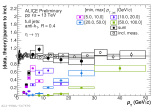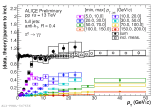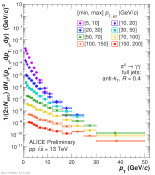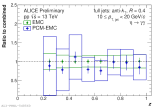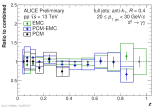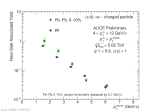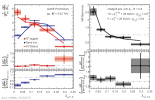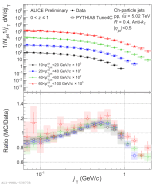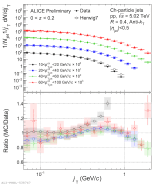Public Preliminary figures by analysis
Mesons inside jets: Figures as function of pT
Eta pT spectra in different jet pT intervals normalized per jet
- Fig. Group : Mesons inside jets: Figures as function of pT
- PWG : PWG-EM (Electromagnetic probes)
- Energy: 13 TeV
- System: p-p
Ratio of fully corrected Pi0 pT spectra inside jets (data and PYTHIA) to parameterization
- Fig. Group : Mesons inside jets: Figures as function of pT
- PWG : PWG-EM (Electromagnetic probes)
- Energy: 13 TeV
- System: p-p
Pi0 pT spectra in different jet pT intervals normalized per jet
- Fig. Group : Mesons inside jets: Figures as function of pT
- PWG : PWG-EM (Electromagnetic probes)
- Energy: 13 TeV
- System: p-p
Ratio of Eta pT spectra in different jet pT intervals to a fit to the inclusive Eta spectrum
- Fig. Group : Mesons inside jets: Figures as function of pT
- PWG : PWG-EM (Electromagnetic probes)
- Energy: 13 TeV
- System: p-p
Eta pT spectra in different jet pT intervals normalized per event
- Fig. Group : Mesons inside jets: Figures as function of pT
- PWG : PWG-EM (Electromagnetic probes)
- Energy: 13 TeV
- System: p-p
Ratio of Pi0 pT spectra in different jet pT intervals to a fit to the inclusive Pi0 spectrum
- Fig. Group : Mesons inside jets: Figures as function of pT
- PWG : PWG-EM (Electromagnetic probes)
- Energy: 13 TeV
- System: p-p
Pi0 pT spectra in different jet pT intervals normalized per event and the inclusive Pi0 spectrum
- Fig. Group : Mesons inside jets: Figures as function of pT
- PWG : PWG-EM (Electromagnetic probes)
- Energy: 13 TeV
- System: p-p
Pi0 pT spectra in different jet pT intervals normalized per event
- Fig. Group : Mesons inside jets: Figures as function of pT
- PWG : PWG-EM (Electromagnetic probes)
- Energy: 13 TeV
- System: p-p
Mesons inside jets: Figures as function of z
Comparison of corrected Eta spectra inside jets from different reconstruction methods as function of z
- Fig. Group : Mesons inside jets: Figures as function of z
- PWG : PWG-EM (Electromagnetic probes)
- Energy: 13 TeV
- System: p-p
Comparison of corrected Pi0 spectra inside jets from different reconstruction methods as function of z
- Fig. Group : Mesons inside jets: Figures as function of z
- PWG : PWG-EM (Electromagnetic probes)
- Energy: 13 TeV
- System: p-p
Azimuthal correlations between heavy-flavour decay electrons and charged particles in Pb-Pb collisions at 5.02 TeV
Delta Phi Distribution of heavy-flavor decay electrons and charged particles, Pb-Pb 30 - 50% Centrality and pp
- Fig. Group : Azimuthal correlations between heavy-flavour decay electrons and charged particles in Pb-Pb collisions at 5.02 TeV
- PWG : PWG-HF (Heavy Flavour)
- Energy: 5.02 TeV
- System: Pb-Pb
Delta Phi Distribution of heavy-flavor decay electrons and charged particles, Pb-Pb 0 - 10% Centrality and pp
- Fig. Group : Azimuthal correlations between heavy-flavour decay electrons and charged particles in Pb-Pb collisions at 5.02 TeV
- PWG : PWG-HF (Heavy Flavour)
- Energy: 5.02 TeV
- System: Pb-Pb
Delta Phi Distribution of heavy-flavor decay electrons and charged particles with background uncertainty, Pb-Pb 30 - 50% Centrality
- Fig. Group : Azimuthal correlations between heavy-flavour decay electrons and charged particles in Pb-Pb collisions at 5.02 TeV
- PWG : PWG-HF (Heavy Flavour)
- Energy: 5.02 TeV
- System: Pb-Pb
Delta Phi Distribution of heavy-flavor decay electrons and charged particles with background uncertainty, Pb-Pb 0 - 10% Centrality
- Fig. Group : Azimuthal correlations between heavy-flavour decay electrons and charged particles in Pb-Pb collisions at 5.02 TeV
- PWG : PWG-HF (Heavy Flavour)
- Energy: 5.02 TeV
- System: Pb-Pb
Away-Side Nuclear Modification factor ($I_{AA}$) of Pb-Pb in 30 - 50% Centrality
- Fig. Group : Azimuthal correlations between heavy-flavour decay electrons and charged particles in Pb-Pb collisions at 5.02 TeV
- PWG : PWG-HF (Heavy Flavour)
- Energy: 5.02 TeV
- System: Pb-Pb
Away-Side Nuclear Modification factor ($I_{AA}$) of Pb-Pb in 0 - 10% Centrality
- Fig. Group : Azimuthal correlations between heavy-flavour decay electrons and charged particles in Pb-Pb collisions at 5.02 TeV
- PWG : PWG-HF (Heavy Flavour)
- Energy: 5.02 TeV
- System: Pb-Pb
Near-Side Nuclear Modification factor ($I_{AA}$) of Pb-Pb in 30 - 50% Centrality
- Fig. Group : Azimuthal correlations between heavy-flavour decay electrons and charged particles in Pb-Pb collisions at 5.02 TeV
- PWG : PWG-HF (Heavy Flavour)
- Energy: 5.02 TeV
- System: Pb-Pb
Near-Side Nuclear Modification factor ($I_{AA}$) of Pb-Pb in 0 - 10% Centrality
- Fig. Group : Azimuthal correlations between heavy-flavour decay electrons and charged particles in Pb-Pb collisions at 5.02 TeV
- PWG : PWG-HF (Heavy Flavour)
- Energy: 5.02 TeV
- System: Pb-Pb
Comparison of Per-Trigger Associated Away-Side Yield in Pb-Pb 30 - 50% Centrality and pp
- Fig. Group : Azimuthal correlations between heavy-flavour decay electrons and charged particles in Pb-Pb collisions at 5.02 TeV
- PWG : PWG-HF (Heavy Flavour)
- Energy: 5.02 TeV
- System: Pb-Pb
Comparison of Per-Trigger Associated Away-Side Yield in Pb-Pb 0 - 10% Centrality and pp
- Fig. Group : Azimuthal correlations between heavy-flavour decay electrons and charged particles in Pb-Pb collisions at 5.02 TeV
- PWG : PWG-HF (Heavy Flavour)
- Energy: 5.02 TeV
- System: Pb-Pb
Comparison of Per-Trigger Associated Near-Side Yield in Pb-Pb 30 - 50% Centrality and pp
- Fig. Group : Azimuthal correlations between heavy-flavour decay electrons and charged particles in Pb-Pb collisions at 5.02 TeV
- PWG : PWG-HF (Heavy Flavour)
- Energy: 5.02 TeV
- System: Pb-Pb
Comparison of Per-Trigger Associated Near-Side Yield in Pb-Pb 0 - 10% Centrality and pp
- Fig. Group : Azimuthal correlations between heavy-flavour decay electrons and charged particles in Pb-Pb collisions at 5.02 TeV
- PWG : PWG-HF (Heavy Flavour)
- Energy: 5.02 TeV
- System: Pb-Pb
Polarization of photoproduced J/psi in Pb-Pb (QM2023)
Comparison of $\lambda_{\theta}$ with UPC measurement
- Fig. Group : Polarization of photoproduced J/psi in Pb-Pb (QM2023)
- PWG : PWG-DQ (Dileptons and Quarkonia)
- Energy: 5.02 TeV
- System: Pb-Pb
dNdcostheta vs costheta in Pb--Pb collisions at 5.02 TeV using Helicity Frame
- Fig. Group : Polarization of photoproduced J/psi in Pb-Pb (QM2023)
- PWG : PWG-DQ (Dileptons and Quarkonia)
- Energy: 5.02 TeV
- System: Pb-Pb
Invariant mass distribution of dimuon pairs for 0.5 < |cos\theta| < 0.6 in Pb-Pb collsions at 5.02 TeV
- Fig. Group : Polarization of photoproduced J/psi in Pb-Pb (QM2023)
- PWG : PWG-DQ (Dileptons and Quarkonia)
- Energy: 5.02 TeV
- System: Pb-Pb
Invariant mass distribution of dimuon pairs for 0.2 < |cos\theta| < 0.3 in Pb-Pb collsions at 5.02 TeV
- Fig. Group : Polarization of photoproduced J/psi in Pb-Pb (QM2023)
- PWG : PWG-DQ (Dileptons and Quarkonia)
- Energy: 5.02 TeV
- System: Pb-Pb
Invariant mass distribution of dimuon pairs for 0.0 < |cos\theta| < 0.1 in Pb-Pb collsions at 5.02 TeV
- Fig. Group : Polarization of photoproduced J/psi in Pb-Pb (QM2023)
- PWG : PWG-DQ (Dileptons and Quarkonia)
- Energy: 5.02 TeV
- System: Pb-Pb
Upsilon cross section in pp collisions at 13 TeV (HP2023)
y-differential upsilon(1S) and upsilon(2S) pp cross section at 13 TeV compared to ICEM+FONLL
- Fig. Group : Upsilon cross section in pp collisions at 13 TeV (HP2023)
- PWG : PWG-DQ (Dileptons and Quarkonia)
- Energy: 13 TeV
- System: p-p
pT differential Upsilon(1S) and upsilon(2S) cross section in pp collisions at 13 TeV compared to ICEM+FONLL
- Fig. Group : Upsilon cross section in pp collisions at 13 TeV (HP2023)
- PWG : PWG-DQ (Dileptons and Quarkonia)
- Energy: 13 TeV
- System: p-p
Integrated Upsilon(1S) and Upsilon(2S) cross section as a function of energy compared to ICEM+FONLL model calculations
- Fig. Group : Upsilon cross section in pp collisions at 13 TeV (HP2023)
- PWG : PWG-DQ (Dileptons and Quarkonia)
- Energy: 13 TeV
- System: p-p
pT differential Upsilon(1S) and upsilon(2S) cross section in pp collisions at 13 TeV compared to LHCb
- Fig. Group : Upsilon cross section in pp collisions at 13 TeV (HP2023)
- PWG : PWG-DQ (Dileptons and Quarkonia)
- Energy: 13 TeV
- System: p-p
y-differential upsilon(1S) pp cross section at 13 TeV compared to lower energy ALICE data
- Fig. Group : Upsilon cross section in pp collisions at 13 TeV (HP2023)
- PWG : PWG-DQ (Dileptons and Quarkonia)
- Energy: 13 TeV
- System: p-p
y-differential upsilon(1S) and upsilon(2S) pp cross section at 13 TeV compared to LHCb
- Fig. Group : Upsilon cross section in pp collisions at 13 TeV (HP2023)
- PWG : PWG-DQ (Dileptons and Quarkonia)
- Energy: 13 TeV
- System: p-p
y-differential upsilon(1S) and upsilon(2S) pp cross section at 13 TeV
- Fig. Group : Upsilon cross section in pp collisions at 13 TeV (HP2023)
- PWG : PWG-DQ (Dileptons and Quarkonia)
- Energy: 13 TeV
- System: p-p
pT differential Upsilon(1S) and Upsilon(2S) cross section in pp collisions at 13 TeV
- Fig. Group : Upsilon cross section in pp collisions at 13 TeV (HP2023)
- PWG : PWG-DQ (Dileptons and Quarkonia)
- Energy: 13 TeV
- System: p-p
pT differential Upsilon(1S) cross section in pp collisions at 13 TeV compared to lower energy ALICE data
- Fig. Group : Upsilon cross section in pp collisions at 13 TeV (HP2023)
- PWG : PWG-DQ (Dileptons and Quarkonia)
- Energy: 13 TeV
- System: p-p
D0-tagged jet angularity measurement in pp collisions at $\sqrt{s}$ = 5.02 TeV
D0-tagged jets compared to semi-inclusive jets and to PYTHIA 8 on left and to their ratio on right for $\alpha=3$, $R=0.4$ in 10 < $p_{\rm T, ch. jet}$ < 20 GeV/c.
- Fig. Group : D0-tagged jet angularity measurement in pp collisions at $\sqrt{s}$ = 5.02 TeV
- PWG : PWG-HF (Heavy Flavour)
- Energy: 5.02 TeV
- System: p-p
D0-tagged jets compared to semi-inclusive jets and to PYTHIA 8 on left and to their ratio on right for $\alpha=2$, $R=0.4$ in 10 < $p_{\rm T, ch. jet}$ < 20 GeV/c.
- Fig. Group : D0-tagged jet angularity measurement in pp collisions at $\sqrt{s}$ = 5.02 TeV
- PWG : PWG-HF (Heavy Flavour)
- Energy: 5.02 TeV
- System: p-p
D0-tagged jets compared to semi-inclusive jets and to PYTHIA 8 on left and to their ratio on right for $\alpha=1.5$, $R=0.4$ in 10 < $p_{\rm T, ch. jet}$ < 20 GeV/c.
- Fig. Group : D0-tagged jet angularity measurement in pp collisions at $\sqrt{s}$ = 5.02 TeV
- PWG : PWG-HF (Heavy Flavour)
- Energy: 5.02 TeV
- System: p-p
D0-tagged jets compared to semi-inclusive jets and to PYTHIA 8 on left and to their ratio on right for $\alpha=1$, $R=0.4$ in 10 < $p_{\rm T, ch. jet}$ < 20 GeV/c.
- Fig. Group : D0-tagged jet angularity measurement in pp collisions at $\sqrt{s}$ = 5.02 TeV
- PWG : PWG-HF (Heavy Flavour)
- Energy: 5.02 TeV
- System: p-p
Feed-down fraction in D$^{0}$-tagged jet angularity in 10 < $p_{\rm T, ch. jet}$ < 20 GeV/c and 5 < $p_{\rm T,D^{0}}$ < 20 GeV/c for R = 0.4, $\alpha=1$.
- Fig. Group : D0-tagged jet angularity measurement in pp collisions at $\sqrt{s}$ = 5.02 TeV
- PWG : PWG-HF (Heavy Flavour)
- Energy: 5.02 TeV
- System: p-p
Fully corrected jet angularity distributions of D0-tagged jet compared to semi-inclusive jets and to PYTHIA 8 for $\alpha=3$, $R=0.4$ in 10 < $p_{\rm T, ch. jet}$ < 20 GeV/c.
- Fig. Group : D0-tagged jet angularity measurement in pp collisions at $\sqrt{s}$ = 5.02 TeV
- PWG : PWG-HF (Heavy Flavour)
- Energy: 5.02 TeV
- System: p-p
Fully corrected jet angularity distributions of D0-tagged jet compared to semi-inclusive jets and to PYTHIA 8 for $\alpha=2$, $R=0.4$ in 10 < $p_{\rm T, ch. jet}$ < 20 GeV/c.
- Fig. Group : D0-tagged jet angularity measurement in pp collisions at $\sqrt{s}$ = 5.02 TeV
- PWG : PWG-HF (Heavy Flavour)
- Energy: 5.02 TeV
- System: p-p
Fully corrected jet angularity distributions of D0-tagged jet compared to semi-inclusive jets and to PYTHIA 8 for $\alpha=1.5$, $R=0.4$ in 10 < $p_{\rm T, ch. jet}$ < 20 GeV/c.
- Fig. Group : D0-tagged jet angularity measurement in pp collisions at $\sqrt{s}$ = 5.02 TeV
- PWG : PWG-HF (Heavy Flavour)
- Energy: 5.02 TeV
- System: p-p
D0-tagged jet raw angularity distributions for $\alpha=1$ in 10 < $p_{\rm T, ch. jet}$ < 20 GeV/c and 8 < $p_{\rm T,D^{0}}$ < 12 GeV/c.
- Fig. Group : D0-tagged jet angularity measurement in pp collisions at $\sqrt{s}$ = 5.02 TeV
- PWG : PWG-HF (Heavy Flavour)
- Energy: 5.02 TeV
- System: p-p
Invariant mass distribution of D$^{0}$-tagged jet candidates with 10 < $p_{\rm T, ch. jet}$ < 20 GeV/c and 8 < $p_{\rm T,D^{0}}$ < 12 GeV/c for R = 0.4.
- Fig. Group : D0-tagged jet angularity measurement in pp collisions at $\sqrt{s}$ = 5.02 TeV
- PWG : PWG-HF (Heavy Flavour)
- Energy: 5.02 TeV
- System: p-p
Fully corrected jet angularity distributions of D0-tagged jet compared to semi-inclusive jets and to PYTHIA 8 for $\alpha=1$, $R=0.4$ in 10 < $p_{\rm T, ch. jet}$ < 20 GeV/c.
- Fig. Group : D0-tagged jet angularity measurement in pp collisions at $\sqrt{s}$ = 5.02 TeV
- PWG : PWG-HF (Heavy Flavour)
- Energy: 5.02 TeV
- System: p-p
Measurement of inclusive jet distributions in central Pb-Pb collisions at 5.02 TeV with a novel mixed-event approach.
Response matrix for R=0.3 jets in central Pb-Pb collisions at 5.02 TeV
- Fig. Group : Measurement of inclusive jet distributions in central Pb-Pb collisions at 5.02 TeV with a novel mixed-event approach.
- PWG : PWG-JE (Jets)
- Energy: 5.02 TeV
- System: Pb-Pb
Corrected jet $p_{T,jet}$ distribution with $p_{T}^{lead} > 5$ GeV/c for central Pb-Pb collisions at 5.02 TeV
- Fig. Group : Measurement of inclusive jet distributions in central Pb-Pb collisions at 5.02 TeV with a novel mixed-event approach.
- PWG : PWG-JE (Jets)
- Energy: 5.02 TeV
- System: Pb-Pb
Raw correlated inclusive jet $p_{T,jet}^{reco}$ distribution for central Pb-Pb collisions at 5.02 TeV
- Fig. Group : Measurement of inclusive jet distributions in central Pb-Pb collisions at 5.02 TeV with a novel mixed-event approach.
- PWG : PWG-JE (Jets)
- Energy: 5.02 TeV
- System: Pb-Pb
Raw correlated quasi-inclusive jet $p_{T,jet}^{reco}$ distribution with $p_{T}^{lead} > 5$ GeV/c for central Pb-Pb collisions at 5.02 TeV
- Fig. Group : Measurement of inclusive jet distributions in central Pb-Pb collisions at 5.02 TeV with a novel mixed-event approach.
- PWG : PWG-JE (Jets)
- Energy: 5.02 TeV
- System: Pb-Pb
Raw inclusive jet $p_{T,jet}^{reco}$ distribution of the SE and ME for central Pb-Pb collisions at 5.02 TeV
- Fig. Group : Measurement of inclusive jet distributions in central Pb-Pb collisions at 5.02 TeV with a novel mixed-event approach.
- PWG : PWG-JE (Jets)
- Energy: 5.02 TeV
- System: Pb-Pb
Raw quasi-inclusive jet $p_{T,jet}^{reco}$ distribution of the SE and ME with $p_{T}^{lead} > 5$ GeV/c for central Pb-Pb collisions at 5.02 TeV
- Fig. Group : Measurement of inclusive jet distributions in central Pb-Pb collisions at 5.02 TeV with a novel mixed-event approach.
- PWG : PWG-JE (Jets)
- Energy: 5.02 TeV
- System: Pb-Pb
Preliminary: Full Jet Spectra - pp 8 TeV, p--Pb 8.16 TeV
Invariant Cross-Section Ratios of Different Jet Radii for pp Full Jet Spectra 8 TeV with Comparison to PYTHIA8
- Fig. Group : Preliminary: Full Jet Spectra - pp 8 TeV, p--Pb 8.16 TeV
- PWG : PWG-JE (Jets)
- Energy: 8 TeV
- System: p-p
Comparison of the Invariant Cross-Section Ratio for R = 0.2/0.5 Full Jets in pp to PYTHIA8 Monash
- Fig. Group : Preliminary: Full Jet Spectra - pp 8 TeV, p--Pb 8.16 TeV
- PWG : PWG-JE (Jets)
- Energy: 8 TeV
- System: p-p
Comparison of the Invariant Cross-Section Ratio for R = 0.2/0.4 Full Jets in pp to PYTHIA8 Monash
- Fig. Group : Preliminary: Full Jet Spectra - pp 8 TeV, p--Pb 8.16 TeV
- PWG : PWG-JE (Jets)
- Energy: 8 TeV
- System: p-p
Comparison of the Invariant Cross-Section Ratio for R = 0.2/0.3 Full Jets in pp to PYTHIA8 Monash
- Fig. Group : Preliminary: Full Jet Spectra - pp 8 TeV, p--Pb 8.16 TeV
- PWG : PWG-JE (Jets)
- Energy: 8 TeV
- System: p-p
Comparison of the Invariant Cross-Section for R = 0.5 Full Jets in pp to PYTHIA8 Monash
- Fig. Group : Preliminary: Full Jet Spectra - pp 8 TeV, p--Pb 8.16 TeV
- PWG : PWG-JE (Jets)
- Energy: 8 TeV
- System: p-p
Comparison of the Invariant Cross-Section for R = 0.4 Full Jets in pp to PYTHIA8 Monash
- Fig. Group : Preliminary: Full Jet Spectra - pp 8 TeV, p--Pb 8.16 TeV
- PWG : PWG-JE (Jets)
- Energy: 8 TeV
- System: p-p
J/psi production in jets at midrapidity in pp collisions at 13 TeV (HP2023)
Fragmentation function of J/psi-tagged charged jets
- Fig. Group : J/psi production in jets at midrapidity in pp collisions at 13 TeV (HP2023)
- PWG : PWG-DQ (Dileptons and Quarkonia)
- Energy: 13 TeV
- System: p-p
Fragmentation function of non-prompt J/psi-tagged charged jets
- Fig. Group : J/psi production in jets at midrapidity in pp collisions at 13 TeV (HP2023)
- PWG : PWG-DQ (Dileptons and Quarkonia)
- Energy: 13 TeV
- System: p-p
Fragmentation function of prompt J/psi-tagged charged jets
- Fig. Group : J/psi production in jets at midrapidity in pp collisions at 13 TeV (HP2023)
- PWG : PWG-DQ (Dileptons and Quarkonia)
- Energy: 13 TeV
- System: p-p
f_B signal extraction 0.7 < z < 0.8
- Fig. Group : J/psi production in jets at midrapidity in pp collisions at 13 TeV (HP2023)
- PWG : PWG-DQ (Dileptons and Quarkonia)
- Energy: 13 TeV
- System: p-p
Inclusive jpsi signal extraction, 0.7 < z < 0.8
- Fig. Group : J/psi production in jets at midrapidity in pp collisions at 13 TeV (HP2023)
- PWG : PWG-DQ (Dileptons and Quarkonia)
- Energy: 13 TeV
- System: p-p
Z→e+e− in pp collisions at 13 TeV
Fiducial cross section of Z->ee at mirapidity in pp collisions at 13 TeV
- Fig. Group : Z→e+e− in pp collisions at 13 TeV
- PWG : PWG-HF (Heavy Flavour)
- Energy: 13 TeV
- System: p-p
Invariant mass of Z->ee (ULS and LS pairs) at midrapidity in pp collisions at 13 TeV
- Fig. Group : Z→e+e− in pp collisions at 13 TeV
- PWG : PWG-HF (Heavy Flavour)
- Energy: 13 TeV
- System: p-p
Invariant mass of Z->ee at midrapidity in pp collisions at 13 TeV
- Fig. Group : Z→e+e− in pp collisions at 13 TeV
- PWG : PWG-HF (Heavy Flavour)
- Energy: 13 TeV
- System: p-p
Ds-jet longitudinal momentum fraction in pp collisions at 13 TeV
The comparison of longitudinal momentum fraction of $\rm D_{s}^{+}$ and $\rm D^{0}$ -tagged jets in MB pp collisions at 13 TeV
- Fig. Group : Ds-jet longitudinal momentum fraction in pp collisions at 13 TeV
- PWG : PWG-HF (Heavy Flavour)
- Energy: 13 TeV
- System: p-p
Longitudinal momentum fraction of $\rm D_{s}^{+}$-tagged jets in MB pp collisions at 13 TeV
- Fig. Group : Ds-jet longitudinal momentum fraction in pp collisions at 13 TeV
- PWG : PWG-HF (Heavy Flavour)
- Energy: 13 TeV
- System: p-p
Relative statistical and systematic uncertainties by categories of $\rm D_{s}^{+}$-tagged jets longitudinal momentum fraction in MB pp collisions at 13 TeV
- Fig. Group : Ds-jet longitudinal momentum fraction in pp collisions at 13 TeV
- PWG : PWG-HF (Heavy Flavour)
- Energy: 13 TeV
- System: p-p
Feed-down contribution of $\rm D_{s}^{+}$ jets from POWHEG+PYTHIA6+EvtGen in MB pp collisions at 13 TeV
- Fig. Group : Ds-jet longitudinal momentum fraction in pp collisions at 13 TeV
- PWG : PWG-HF (Heavy Flavour)
- Energy: 13 TeV
- System: p-p
Invariant mass distribution of $\rm D_{s}^{+}$ candidates inside jets in MB pp collisions at 13 TeV
- Fig. Group : Ds-jet longitudinal momentum fraction in pp collisions at 13 TeV
- PWG : PWG-HF (Heavy Flavour)
- Energy: 13 TeV
- System: p-p
Energy flow within jets in pp and Pb-Pb collisions with ALICE
Energy flow distributions overview Charged jets 60-80 GeV pp 13 TeV, R=0.05 to 0.1, R=0.2 to 0.25 and R=0.35 to 0.4
- Fig. Group : Energy flow within jets in pp and Pb-Pb collisions with ALICE
- PWG : PWG-JE (Jets)
- Energy: 13 TeV
- System: p-p
Energy flow distributions overview Charged jets 40-60 GeV pp 13 TeV, R=0.05 to 0.1, R=0.2 to 0.25 and R=0.35 to 0.4
- Fig. Group : Energy flow within jets in pp and Pb-Pb collisions with ALICE
- PWG : PWG-JE (Jets)
- Energy: 13 TeV
- System: p-p
Energy flow distributions overview Charged jets 60-80 GeV pp 13 TeV, All Rjet pairs
- Fig. Group : Energy flow within jets in pp and Pb-Pb collisions with ALICE
- PWG : PWG-JE (Jets)
- Energy: 13 TeV
- System: p-p
Energy flow distributions overview Charged jets 40-60 GeV pp 13 TeV, All Rjet pairs
- Fig. Group : Energy flow within jets in pp and Pb-Pb collisions with ALICE
- PWG : PWG-JE (Jets)
- Energy: 13 TeV
- System: p-p
Energy flow distributions with model comparison Charged jets 60-80 GeV pp 13 TeV, R=0.35 to R=0.4
- Fig. Group : Energy flow within jets in pp and Pb-Pb collisions with ALICE
- PWG : PWG-JE (Jets)
- Energy: 13 TeV
- System: p-p
Energy flow distributions with model comparison Charged jets 40-60 GeV pp 13 TeV, R=0.35 to R=0.4
- Fig. Group : Energy flow within jets in pp and Pb-Pb collisions with ALICE
- PWG : PWG-JE (Jets)
- Energy: 13 TeV
- System: p-p
Energy flow distributions with model comparison Charged jets 60-80 GeV pp 13 TeV, R=0.2 to R=0.25
- Fig. Group : Energy flow within jets in pp and Pb-Pb collisions with ALICE
- PWG : PWG-JE (Jets)
- Energy: 13 TeV
- System: p-p
Energy flow distributions with model comparison Charged jets 40-60 GeV pp 13 TeV, R=0.2 to R=0.25
- Fig. Group : Energy flow within jets in pp and Pb-Pb collisions with ALICE
- PWG : PWG-JE (Jets)
- Energy: 13 TeV
- System: p-p
Energy flow distributions with model comparison Charged jets 60-80 GeV pp 13 TeV, R=0.05 to R=0.1
- Fig. Group : Energy flow within jets in pp and Pb-Pb collisions with ALICE
- PWG : PWG-JE (Jets)
- Energy: 13 TeV
- System: p-p
Energy flow distributions with model comparison Charged jets 40-60 GeV pp 13 TeV, R=0.05 to R=0.1
- Fig. Group : Energy flow within jets in pp and Pb-Pb collisions with ALICE
- PWG : PWG-JE (Jets)
- Energy: 13 TeV
- System: p-p
Mean energy flow versus jet radius with model comparison Charged jets 60-80 GeV pp 13 TeV
- Fig. Group : Energy flow within jets in pp and Pb-Pb collisions with ALICE
- PWG : PWG-JE (Jets)
- Energy: 13 TeV
- System: p-p
Mean energy flow versus jet radius with model comparison Charged jets 40-60 GeV pp 13 TeV
- Fig. Group : Energy flow within jets in pp and Pb-Pb collisions with ALICE
- PWG : PWG-JE (Jets)
- Energy: 13 TeV
- System: p-p
Mean energy flow versus jet radius with jet pt dependence Charged jets pp 13 TeV
- Fig. Group : Energy flow within jets in pp and Pb-Pb collisions with ALICE
- PWG : PWG-JE (Jets)
- Energy: 13 TeV
- System: p-p
[poster] Measurement of the transverse momentum($j_T$) distributions of charged-particle jet fragments in pp collisions at $\sqrt{s}$ = 5.02 TeV with ALICE
Measured $j_\mathrm{T}$ distributions in high $z$ bin compared to PYTHIA8 Tune4C
- Fig. Group : [poster] Measurement of the transverse momentum($j_T$) distributions of charged-particle jet fragments in pp collisions at $\sqrt{s}$ = 5.02 TeV with ALICE
- PWG : PWG-JE (Jets)
- Energy: 5.02 TeV
- System: p-p
Measured $j_\mathrm{T}$ distributions in mid $z$ bin compared to PYTHIA8 Tune4C
- Fig. Group : [poster] Measurement of the transverse momentum($j_T$) distributions of charged-particle jet fragments in pp collisions at $\sqrt{s}$ = 5.02 TeV with ALICE
- PWG : PWG-JE (Jets)
- Energy: 5.02 TeV
- System: p-p
Measured $j_\mathrm{T}$ distributions in low $z$ bin compared to PYTHIA8 Tune4C
- Fig. Group : [poster] Measurement of the transverse momentum($j_T$) distributions of charged-particle jet fragments in pp collisions at $\sqrt{s}$ = 5.02 TeV with ALICE
- PWG : PWG-JE (Jets)
- Energy: 5.02 TeV
- System: p-p
Measured $j_\mathrm{T}$ distributions in inclusive $z$ bin compared to PYTHIA8 Tune4C
- Fig. Group : [poster] Measurement of the transverse momentum($j_T$) distributions of charged-particle jet fragments in pp collisions at $\sqrt{s}$ = 5.02 TeV with ALICE
- PWG : PWG-JE (Jets)
- Energy: 5.02 TeV
- System: p-p
Measured $j_\mathrm{T}$ distributions in high $z$ bin compared to Herwig
- Fig. Group : [poster] Measurement of the transverse momentum($j_T$) distributions of charged-particle jet fragments in pp collisions at $\sqrt{s}$ = 5.02 TeV with ALICE
- PWG : PWG-JE (Jets)
- Energy: 5.02 TeV
- System: p-p
Measured $j_\mathrm{T}$ distributions in mid $z$ bin compared to Herwig
- Fig. Group : [poster] Measurement of the transverse momentum($j_T$) distributions of charged-particle jet fragments in pp collisions at $\sqrt{s}$ = 5.02 TeV with ALICE
- PWG : PWG-JE (Jets)
- Energy: 5.02 TeV
- System: p-p
Measured $j_\mathrm{T}$ distributions in low $z$ bin compared to Herwig
- Fig. Group : [poster] Measurement of the transverse momentum($j_T$) distributions of charged-particle jet fragments in pp collisions at $\sqrt{s}$ = 5.02 TeV with ALICE
- PWG : PWG-JE (Jets)
- Energy: 5.02 TeV
- System: p-p
Measured $j_\mathrm{T}$ distributions in inclusive $z$ bin compared to Herwig
- Fig. Group : [poster] Measurement of the transverse momentum($j_T$) distributions of charged-particle jet fragments in pp collisions at $\sqrt{s}$ = 5.02 TeV with ALICE
- PWG : PWG-JE (Jets)
- Energy: 5.02 TeV
- System: p-p
Measurement of heavy-flavor production in the high-mass dimuon spectrum in pp collisions at sqrt{s}=13 TeV with ALICE (HP2023)
[HP 2023] Beauty cross section as a function of rapidity compared with FONLL prediction (NNPDF pdf)
- Fig. Group : Measurement of heavy-flavor production in the high-mass dimuon spectrum in pp collisions at sqrt{s}=13 TeV with ALICE (HP2023)
- PWG : PWG-DQ (Dileptons and Quarkonia)
- Energy: 13 TeV
- System: p-p
[HP 2023] Beauty cross section as a function of rapidity compared with FONLL prediction (CTEQ6 pdf)
- Fig. Group : Measurement of heavy-flavor production in the high-mass dimuon spectrum in pp collisions at sqrt{s}=13 TeV with ALICE (HP2023)
- PWG : PWG-DQ (Dileptons and Quarkonia)
- Energy: 13 TeV
- System: p-p
[HP 2023] Charm cross section as a function of rapidity compared with FONLL prediction (CTEQ6 pdf)
- Fig. Group : Measurement of heavy-flavor production in the high-mass dimuon spectrum in pp collisions at sqrt{s}=13 TeV with ALICE (HP2023)
- PWG : PWG-DQ (Dileptons and Quarkonia)
- Energy: 13 TeV
- System: p-p
[HP 2023] Charm cross section as a function of rapidity compared with FONLL prediction (NNPDF pdf)
- Fig. Group : Measurement of heavy-flavor production in the high-mass dimuon spectrum in pp collisions at sqrt{s}=13 TeV with ALICE (HP2023)
- PWG : PWG-DQ (Dileptons and Quarkonia)
- Energy: 13 TeV
- System: p-p
[HP 2023] Simultaneous unbinned fit to dimuon data distribution (transverse momentum component)
- Fig. Group : Measurement of heavy-flavor production in the high-mass dimuon spectrum in pp collisions at sqrt{s}=13 TeV with ALICE (HP2023)
- PWG : PWG-DQ (Dileptons and Quarkonia)
- Energy: 13 TeV
- System: p-p
[HP 2023] Simultaneous unbinned fit to dimuon data distribution (mass component)
- Fig. Group : Measurement of heavy-flavor production in the high-mass dimuon spectrum in pp collisions at sqrt{s}=13 TeV with ALICE (HP2023)
- PWG : PWG-DQ (Dileptons and Quarkonia)
- Energy: 13 TeV
- System: p-p
[HP 2023] Dimuon invariant mass distribution with m>4 Gev/c^2
- Fig. Group : Measurement of heavy-flavor production in the high-mass dimuon spectrum in pp collisions at sqrt{s}=13 TeV with ALICE (HP2023)
- PWG : PWG-DQ (Dileptons and Quarkonia)
- Energy: 13 TeV
- System: p-p




